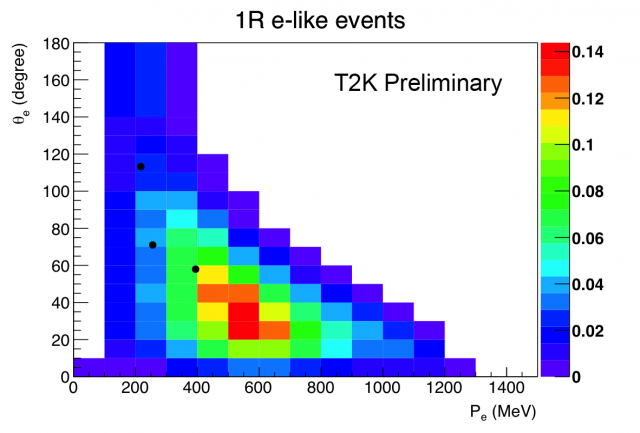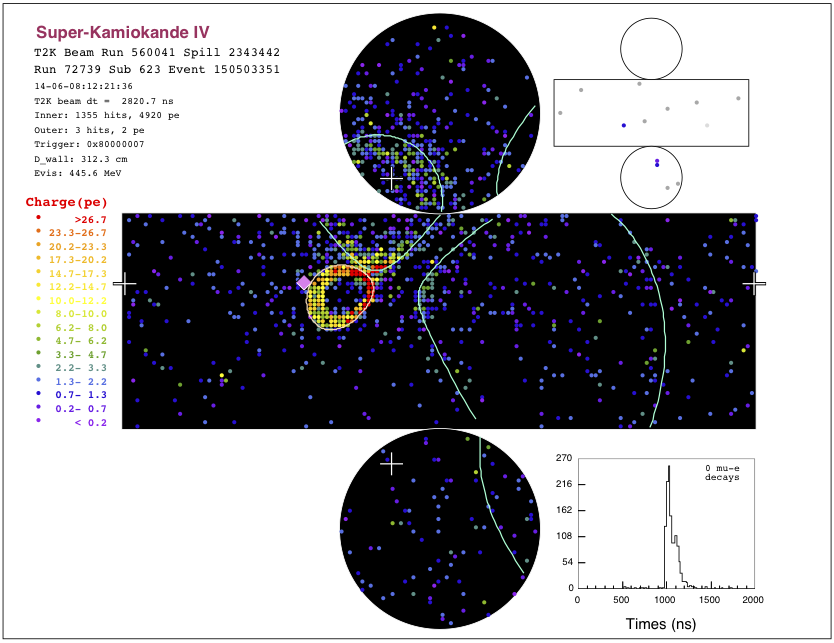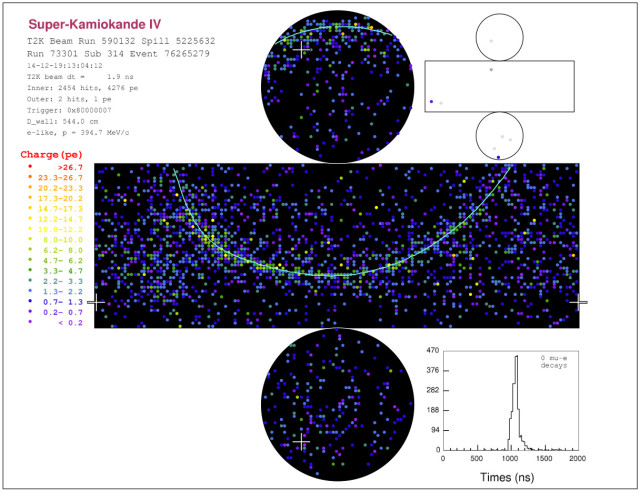T2K physics coordinator Sara Bolognesi received the EPS Emmy Noether Distinction for Women in Physics 2022
During the European Physical Society (EPS) Forum, held in Paris on June 2-3, 2022.

While the short motivation of the prize talks about Sara contributions to the CMS experiment: “for her development of data analysis techniques that conclusively improved the sensitivity of the CERN-CMS experiment, thus allowing the discovery of the Higgs boson and the first measurement of its spin and parity”, it was made clear that her decision to change field and her contributions to the T2K experiment played an important role for the appointment of the award.
T2K Results Restrict Possible Values of Neutrino CP Phase
– Published in Nature, the results are a major step forward in the study of difference between matter and antimatter
https://www.nature.com/articles/s41586-020-2177-0

The T2K Collaboration has published new results showing the strongest constraint yet on the parameter that governs the breaking of the symmetry between matter and antimatter in neutrino oscillations. Using beams of muon neutrinos and muon antineutrinos, T2K has studied how these particles and antiparticles transition into electron neutrinos and electron antineutrinos, respectively. The parameter governing the matter/antimatter symmetry breaking in neutrino oscillation, called δcp phase, can take a value from -180º to 180º. For the first time, T2K has disfavored almost half of the possible values at the 99.7% (3σ) confidence level, and is starting to reveal a basic property of neutrinos that has not been measured until now. This is an important step on the way to knowing whether or not neutrinos and antineutrinos behave differently. These results, using data collected through 2018, have been published in the multidisciplinary scientific journal, Nature on April 16.
For most phenomena, the laws of physics provide a symmetric description of the behavior of matter and antimatter. However, this symmetry does not hold universally. The effect of the
asymmetry between matter and antimatter is most apparent in the observation of the universe, which is composed of matter with little antimatter. It is considered that equal amounts of matter and antimatter were created at the beginning of the universe. Then, for the universe to evolve to a state where matter dominates over antimatter, a necessary condition is the violation of the so-called Charge-Parity (CP) symmetry. Until now, CP symmetry violation has only been observed in the physics of subatomic particles called quarks, but the magnitude of the CP symmetry violation is not large enough to explain the observed dominance of matter over antimatter in the universe. T2K is now searching for a new source of CP symmetry violation in neutrino oscillations that would manifest as a difference in the measured oscillation probability for neutrinos and antineutrinos.

| Fig.1 The arrow indicates the value most compatible with the data. The gray region is disfavored at 99.7% (3s) confidence level. Nearly half of the possible values are excluded. |
The T2K experiment uses a beam consisting primarily of muon neutrinos or muon antineutrinos created using the proton beam from the Japan Proton Accelerator Research Complex (J-PARC) located in Tokai village on the east coast of Japan. A small fraction of the neutrinos (or antineutrinos) are detected 295 km away at the Super-Kamiokande detector, located under a mountain in Kamioka, near the west coast of Japan. As the muon neutrinos and muon antineutrinos traverse the distance from Tokai to Kamioka (hence the name T2K), a fraction will oscillate or change flavor into electron neutrinos or electron antineutrinos respectively. The electron neutrinos and electron antineutrinos are identified in the Super-Kamiokande detector by the rings of Cherenkov light that they produce (shown below). While Super-Kamiokande cannot identify each event as a neutrino or antineutrino interaction, T2K is able to study the neutrino and antineutrino oscillations separately by operating the beam in neutrino mode or antineutrino mode.

| Fig.2 Event displays of candidate electron neutrino (left) and electron antineutrino (right) events observed in Super-K from the T2K neutrino beam. When an electron neutrino or antineutrino interacts with water, an electron or positron is produced. They emit a faint ring pattern light, which is detected by about 11,000 photo-sensors. The color in the displays represents the photon detection timing. |
T2K released a result analysing data with 1.49×1021 and 1.64×1021 protons from the accelerator for neutrino beam mode and antineutrino beam mode respectively. If the parameter δcp equals 0º or 180º, the neutrinos and antineutrinos will change their types (from muon to electron) in the same way during oscillation. The δcp parameter may have a value that enhances the oscillations of neutrinos or antineutrinos, breaking CP symmetry. However, the observation of neutrinos is already enhanced in the T2K experiment by the fact that the detectors and beam line components are made out of matter and not antimatter. To separate the effect of δcp from known beam line and interaction effects, the T2K analysis includes corrections based on data from magnetized near detectors (ND280) placed 280m from the target. T2K observed 90 electron neutrino candidates and 15 electron antineutrino candidates. T2K expects to observe 82 electron neutrino events compared to 17 electron antineutrino events for maximal neutrino enhancement (δcp =-90º) and 56 electron neutrino events compared to 22 electron antineutrino events for maximal antineutrino enhancement (δcp=+90º). The observed number of events as a function of the reconstructed neutrino energy is shown below. The T2K data is most compatible with a value close to δcp=-90º that significantly enhances the oscillation probability of neutrinos in the T2K experiment. Using this data, T2K evaluates confidence intervals for the parameter δcp. The disfavored region at the 3σ (99.7%) confidence level is -2º to 165º. This result represents the strongest constraint on δcp to date. The values of 0º and 180º are disfavored at 95% confidence level , which was the case in T2K’s previous release in 2017, indicating that CP symmetry may be violated in neutrino oscillations.

| Fig.3 The observed electron neutrino (left) and electron antineutrino (right) candidate events with predictions for maximal neutrino enhancement (red, long dash) and maximum antineutrino enhancement (blue, short dash). |

| Table The observed number of electron neutrino and electron antineutrino candidate events with expectations for maximal neutrino enhancement (δcp=-90º) and maximum antineutrino enhancement (δcp=+90º ). |
While this result shows a strong preference for enhancement of the neutrino rate in T2K, it is not yet clear if CP symmetry is violated or not. To further improve the experimental sensitivity to a potential CP symmetry violating effect, the T2K Collaboration will upgrade the near detector suite to reduce systematic uncertainties and accumulate more data, and J-PARC will increase the beam intensity by upgrading the accelerator and beamline.
The T2K experiment is supported by the Japanese Ministry for Culture, Sports, Science, and Technology (MEXT), and is jointly hosted by the High Energy Accelerator Research Organization (KEK) and the University of Tokyo’s Institute for Cosmic Ray Research (ICRR). The T2K experiment was constructed and is operated by an international collaboration, which currently consists of nearly 500 scientists from 68 institutions in 12 countries [Canada, France, Germany, Italy, Japan, Poland, Russia, Spain, Switzerland, UK, USA and Vietnam]. This result is made possible by the efforts of J-PARC to deliver high-quality beam to T2K.
T2K Run 10 ended with record beam power
T2K ended its 2019-2020 data-taking run on February 12, 2020, with a record beam power of 515 kW stably delivered by the J-PARC Main Ring accelerator. T2K has accumulated a total of 3.64×10^21 protons on target (POT) so far.

The protons are produced by the J-PARC Main Ring synchrotron accelerator in Tokai on the east coast of Japan. The 30 GeV protons are directed onto a graphite target, producing charged pions and other secondary particles. These pions pass through three magnetic “horns,” which are able to preferentially focus either positively-charged or negatively-charged pions in the direction of T2K’s neutrino detectors. Positively charged pions quickly decay to produce muon neutrinos, while negatively charged pions decay to produce muon antineutrinos. This allows T2K to produce a beam composed mostly of muon neutrinos or muon antineutrinos by changing the direction of the magnetic horn current.
Atsuko K. Ichikawa from Kyoto University elected Spokesperson of the T2K collaboration.
Atsuko K. Ichikawa from Kyoto University was elected Spokesperson of the T2K collaboration. A.Ichikawa replaces T.Nakaya also from Kyoto University in the position.
Federico Sanchez from the University of Geneva elected International Co-Spokesperson of the T2K collaboration
Federico Sanchez from the University of Geneva elected International Co-Spokesperson of the T2K collaboration replacing Morgan Wacko from Imperial College (UK).
First look at antineutrino appearance from T2K
T2K observes three candidate electron antineutrino events at Super-Kamiokande in the muon antineutrino beam from J-PARC
The predominance of matter over antimatter in the universe points directly to the existence of some currently hidden laws of physics which are different for matter and anti-matter. One focus of the search for these new laws is the recently-discovered phenomenon of neutrino oscillations. Searching for these new laws of physics will require comparing the oscillations of neutrinos and anti-neutrinos.
The T2K collaboration has observed three electron antineutrino candidate events in a muon antineutrino beam. This is the first antineutrino appearance search by the collaboration, which also observed muon antineutrino disappearance earlier this year. The appearance and disappearance of neutrino and antineutrino flavours is called neutrino oscillation and occurs because of the quantum mechanical interference of neutrino masses and flavours.
T2K began collecting data in antineutrino mode in May 2014, and completed its first run in antineutrino mode in June 2015, collecting 10% of their expected antineutrino data set. Before this run, T2K took data in neutrino mode, 2010 — 2013, and definitively established electron neutrino appearance from a muon neutrino beam. Based on the neutrino mode results, T2K would expect to observe 3.8 events, with 1.8 coming from backgrounds. Although three events is too small to draw firm conclusions, it is a first for T2K with antineutrinos.

Distribution of the three electron antineutrino event candidates, shown against the observed electron angle and momentum. The black dots represent the three data events, and the coloured background represents the expectation based on the neutrino mode result.
These events are a clear demonstration of the potential of the T2K experiment to perform a powerful antineutrino oscillation search. T2K will run in antineutrino mode again in the autumn and should collect more than twice the data already in hand, which could give enough data to make a significant observation.
The search for electron antineutrino appearance is the next step in the exploration of charge-parity (CP) symmetry, which stipulates that antimatter should behave just like matter if viewed through a mirror and upside down. CP violation in neutrinos would manifest itself as antineutrinos oscillating differently than neutrinos, and if this happens it is a strong clue as to the origins of the matter/antimatter imbalance in the Universe today.
T2K’s neutrino mode results gave a first hint that CP might be violated by neutrinos. If that is the case, then the electron antineutrino appearance rates will be suppressed. The current level of statistics are not high enough to be sure. For that, T2K will need to continue running long enough to accumulate sufficient data for a large signal.
Concurrent with the release of the electron antineutrino appearance result, T2K has also updated its observation of muon antineutrino disappearance. In this analysis, the collaboration expects to observe 103.6 events passing the muon antineutrino selection requirements, but instead observed just 34. This clear signature of antineutrino disappearance strengthens the collaboration’s already world-best measurement of the antineutrino mixing angle.
The result was announced in a talk given by Dr Melody Ravonel Salzgeber (University of Geneva) at the European Physical Society Conference on High Energy Physics (EPS-HEP 2015) in Vienna on July 23, and was followed by seminars at KEK/J-PARC in Japan by Dr Hidekazu Tanaka (ICRR) and Fermilab in the USA by Prof Kendall Mahn (Michigan State University).
This result is due to the work of the J-PARC Accelerator Division.
T2K’s 2011 PRL paper reaches 1000 citations
T2K sees its first event in antineutrino beam mode

First event in Super-Kamiokande in antineutrino beam mode
T2K makes its beam by colliding a beam of protons with a graphite target. Pions are created by these collisions, and these pions can have either a positive or a negative charge. The pions pass through 3 magnetic horns, and their motion is deflected by the magnetic field. By changing the direction of the current in the magnetic horns, it is possible to focus either positively charged pions or negatively charged pions toward the direction of Super-Kamiokande, the T2K far detector. Positively charged pions quickly decay to muon neutrinos and antimuons, while negatively charged pions decay to muon antineutrinos and muons. This means that T2K can choose whether its beam is composed mostly of muon neutrinos or mostly of muon antineutrinos by changing the direction of the magnetic horn current (the muons or antimuons and any remaining pions are stopped by a second layer of graphite at ~100m downstream of the target).
By comparing oscillations of antineutrinos with oscillations of neutrinos, it might be possible to find a clue to one of the most profound mysteries in science: why does the Universe appear to be composed entirely of matter when it is believed that equal quantities of matter and antimatter were created in the Big Bang? Differences between the oscillations of neutrinos and antineutrinos could provide the answer to this, and, if they exist, these differences would be an example of CP violation. This successful start of the antineutrino mode data taking marks the beginning of our journey to probe CP violation in the lepton sector.
Another aim of taking data in antineutrino beam mode is to make measurements of the interaction cross sections of muon antineutrinos.




